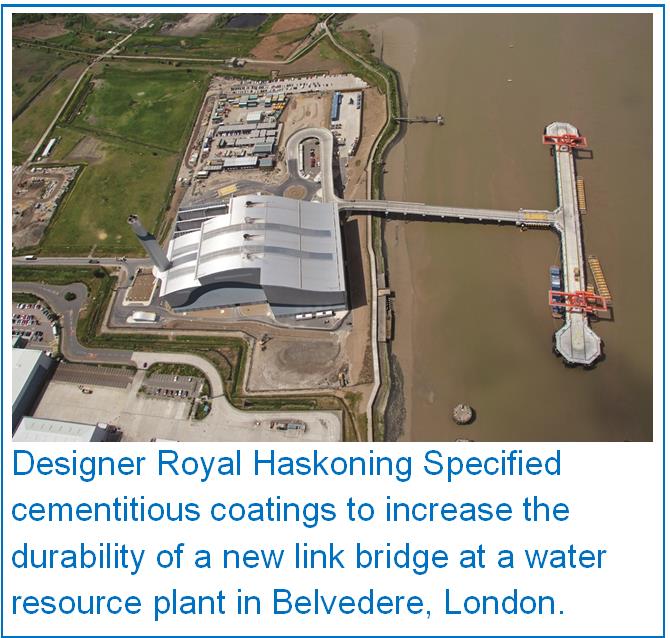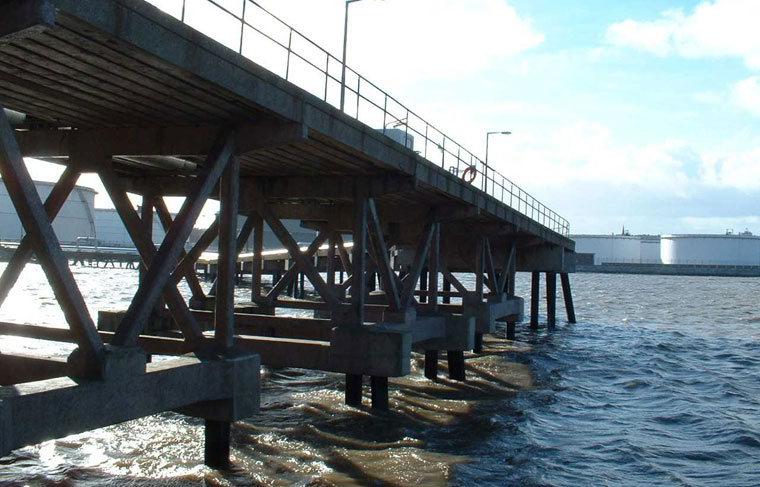The history and demographics of the United Kingdom have been shaped by the fact that we are nation of islands surrounded by the sea, but this also poses significant challenges regarding the durability of reinforced concrete structures in coastal areas.
Demands of Marine Environments
Marine environments impose rigorous and unique demands on those authorities, engineers and specifiers responsible for maintaining the integrity of coastal defences, wharfs and pier deck structures. High chloride levels in seawater, combined with the aggressive action of waves and currents, push structural integrity to the limits, whilst, at the same time, offering only fleeting opportunities for repair and refurbishment. Structures in service need to withstand extreme loading variations from wind and water movement, as well as abrasion damage from waterborne debris.
Embedded steel in reinforced concrete structures is protected against corrosion by the inherently alkaline environment produced by the release of calcium hydroxide as the cement hydrates. This results in the formation of a passivating layer of ferric oxide on the steel reinforcement, and as long as this surface film is maintained, the steel remains protected from corrosion.
However, when compared to the pore sizes within concrete, chloride ions are minutely small and are measured in Angstroms. To use a well-known analogy, if a chloride ion were the size of a tennis ball, then a railway tunnel would be the size of a capillary pore within even good quality concrete. Therefore, when concrete structures are exposed to salt spray or submerged in saltwater, chloride ions easily penetrate concrete, eventually reaching the steel, breaking down the passivating layer and causing corrosion, even under highly alkaline conditions. Corrosion most rapidly occurs in the splash zone where the wet/dry conditions exacerbate chloride penetration and there is enough oxygen to facilitate the corrosion process.
Need to Protect Steel Reinforcement from Corrosion
In tidal and submerged zones, the concrete is saturated and oxygen levels are limited as the pores in the structures are filled with water. Nevertheless, this is no defence in areas where there is low concrete cover and corrosion can still occur, causing a challenge for its reinstatement. As in all construction, the depth and quality of the cover concrete is vital, as this thin layer of concrete protects the reinforcing steel from corrosion by maintaining an alkaline environment and reducing the ingress of chloride ions and other fuels for corrosion. Especially in new construction, elements are identified for low cover during quality control checks on-site and it becomes necessary for remedial measures to enhance durability and ensure the design life of the structure is achieved.
Although reinforced concrete is still considered to be a ‘green’ product, there are increasing demands on engineers and designers to consider the durability and whole life costing of a structure and thereby look to reduce its carbon footprint. With more challenging bridge and tunnel projects being embarked upon in coastal environments, engineers have to consider more effective ways of protecting concrete both in the critical period before it is fully cured as well as throughout its design life. The necessity to cast structures in-situ as well as minimise time in pre-cast yards means that reinforced concrete elements are being subjected to chloride ions when they are at their most vulnerable.
Cementitious Coatings
A more practical, cost-effective means of enhancing durability on new and existing structures is to apply a cementitious coating. There are many products available and it is important to assess factors such as life span and the film thickness required to provide the necessary protection, not to mention successful track record of use on similar structures and independent approvals such as CE Marking in accordance with BS EN 1504.
Test Data
One such product which is regularly specified for enhancing durability on reinforced concrete is Cementitious Coating 851 – a waterborne, cementitious modified polymer coating with a track record of almost 30 years of protecting structures in coastal en
After just 30 days, the control concrete had already reached a ‘steady state of diffusion’ whereby chloride ions are passing through the concrete at a constant rate. In comparison, some 25 years later, chloride ions are still not diffusing through the 2mm film of 851, confirming its long-term ability to resist salt ingress. These results are far and away the best ever seen in such a test with even epoxy coatings succumbing in less than 10 years. In fact, so surprised were the technicians at its performance that after five years they replaced the salt solution in case that was having some influence on the results.
To achieve these barriers properties, the Flexcrete technology utilises a number of different mechanisms to minimise both the porosity and permeability of what is essentially an ultra-thin but highly modified section of concrete. Low water:cement ratio and the use of Pozzolanic materials such as pulverised fuel ash, which react with the lime from the cement hydration to form further hydrates, reduce pore size whilst micro-glass fibres dramatically reduce permeability. However, the most influential raw material is microsilica, which is a by-product of ferro-silicon steel production and is commonly referred to as a super-pozzolan due to its high reactivity with lime. It is 100 times finer than cement and contains material in the nano-particle range, which is capable of blocking the finest pores in a cement matrix. Many investigators have documented the dramatic reduction in the rate of chloride diffusion that can be achieved by incorporating microsilica into concrete, which is largely attributed to the refinement of the pore structure. However, there is also some suggestion that the microsilica particles exhibit some unique chloride ion binding power, which act like a magnet to lock in salts.
This refinement in pore structure also affects other properties and a 2mm film will resist water under 10 bar hydrostatic pressure (100m head of water). Gas diffusion resistance is also enhanced so that 2mm will provide the same resistance to carbon dioxide as 100mm of good quality concrete.
Case Studies
The benefits of cementitious coating technology have been demonstrated in many coastal projects both in the UK and globally.
One prestigious project is a concrete and steel jetty in the North West of England which is capable of handling vessels up to 65,000 tons. In operation since 1960, Cementitious Coating 851 was specified in 1987 in order to extend the service life of the Tranmere Jetty, as inspection of the 70 supporting pillars had uncovered localised concrete spalling and corrosion of the reinforcement due to chloride attack. An inspection in 2010 confirmed that 851 had fulfilled its function as a waterproof, chloride resistant finish in the tidal environment. Following the inspection, Bernard Jones, Technical Director at Mouchel stated: “The application of Cementitious Coating 851 would appear to have been effective in enhancing the durability of the reinforced concrete which had suffered considerable deterioration during the initial 27 years of exposure when the concrete was left without any secondary protection.”
More recently, designers Royal Haskoning specified cementitious coatings to increase the durability on the new link bridge which forms part of the Belvedere Riverside Energy from Waste (EFW) facility in South East London. Cementitious Coating 851 was applied to 91 precast, prestressed beams at Anchor Bay Wharf in Erith prior to transportation to site by barge and installation.
The ability to apply cementitious coatings to ‘green’ or freshly cast concrete led to the selection of 851 for use on caissons for the Kwai Chung Terminal 7 in Hong Kong. Because of their size, these sections were built using slip forming techniques but space restraints meant that they could only be cured for a maximum of seven days before being floated out and sunk into position. Concerns had been raised regarding the ability of the concrete to resist chloride ingress so early in its life and earlier structures on the terminal were already showing signs of deterioration in the harsh South China Sea environment. The decision was made to apply the 851 by spray techniques as soon as the concrete emerged from the slip form to act both as a curing membrane to prevent rapid drying of the concrete but, more importantly, provide chloride protection.
Cementitious coatings have also been well proven in hot and humid climates, as demonstrated by the prestigious Doha Corniche project in Qatar’s capital city of Doha. A waterfront promenade extending for 10km along Doha Bay, Doha Corniche was formed following extensive dredging work carried out during the late 1970s and early 1980s which reshaped Doha’s coastline; the Corniche is now popular among walkers, bikers and joggers. Protection from high seas is provided by a concrete breakwater which suffers from erosion from wave action and chloride induced corrosion of the steel reinforcement. When a new 500 metre precast concrete extension was constructed, the use of a chloride barrier was stipulated to extend the design life. Following consideration of a number of coating systems and intense testing, guided by Halcrow International and Partners, the Ministry of Municipal Affairs and Agriculture (MMAA) specified a 2mm layer of Cementitious Coating 851. Applied in just two coats by spray equipment and bonding intimately to the concrete, 851 provided a durable waterproof layer which will not break down under the harsh direct sunlight.
High performance cementitious coatings present an ideal solution to non-conformance with specification. Not only do they reinstate cover, they also provide structures with additional protection against freeze/thaw cycles, de-icing salts, water and chloride ion penetration, ensuring that the life span of the structure is both achieved and extended.


